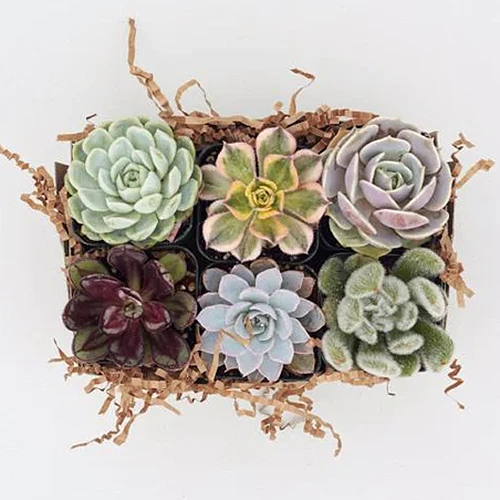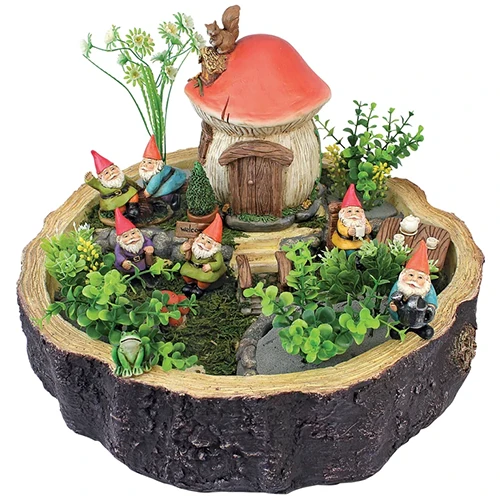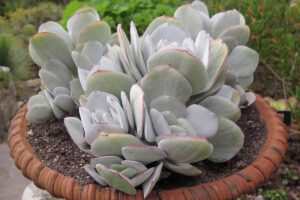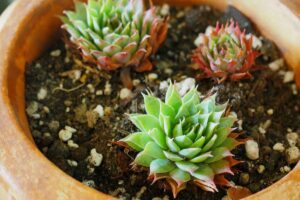Succulents are drought-resistant plants native to arid regions.
Some, like hens and chicks (Echeveria), houseleeks (Sempervivum), and living stones (Lithops), have leaves, but no stems.
Others, like cacti (Cactaceae family), have a stem and no leaves.
And then there are those with a stem and leaves, like the ghost plant (Graptopetalum) and jade plant (Crassula).

We link to vendors to help you find relevant products. If you buy from one of our links, we may earn a commission.
What they all have in common is the ability to store water in plump, fleshy foliage to survive dry spells.
From dwarf species, like living stones that are less than an inch tall, to the 82-foot African baobab, succulents offer a great variety of sizes and colors, shapes, and textures.
And let me warn you: They’re like potato chips, and it’s hard to stop at one once you’ve got a taste for them.
Our guides to growing succulents discuss all you need to know to grow various species in USDA Hardiness Zones 7 to 12 and indoors as houseplants.
This article zeroes in on a unique way to showcase a collection of miniature succulents: the fairy garden. Read on and learn what a fairy garden is and how to make your own.
Here’s what we’ll cover:
What You’ll Learn
Let’s get creative!
What Is a Succulent Fairy Garden?
A fairy garden is a small-scale world of magic and wonder where miniature succulents become trees, shrubs, rocks, and flowers, and tiny beings live their make-believe lives.
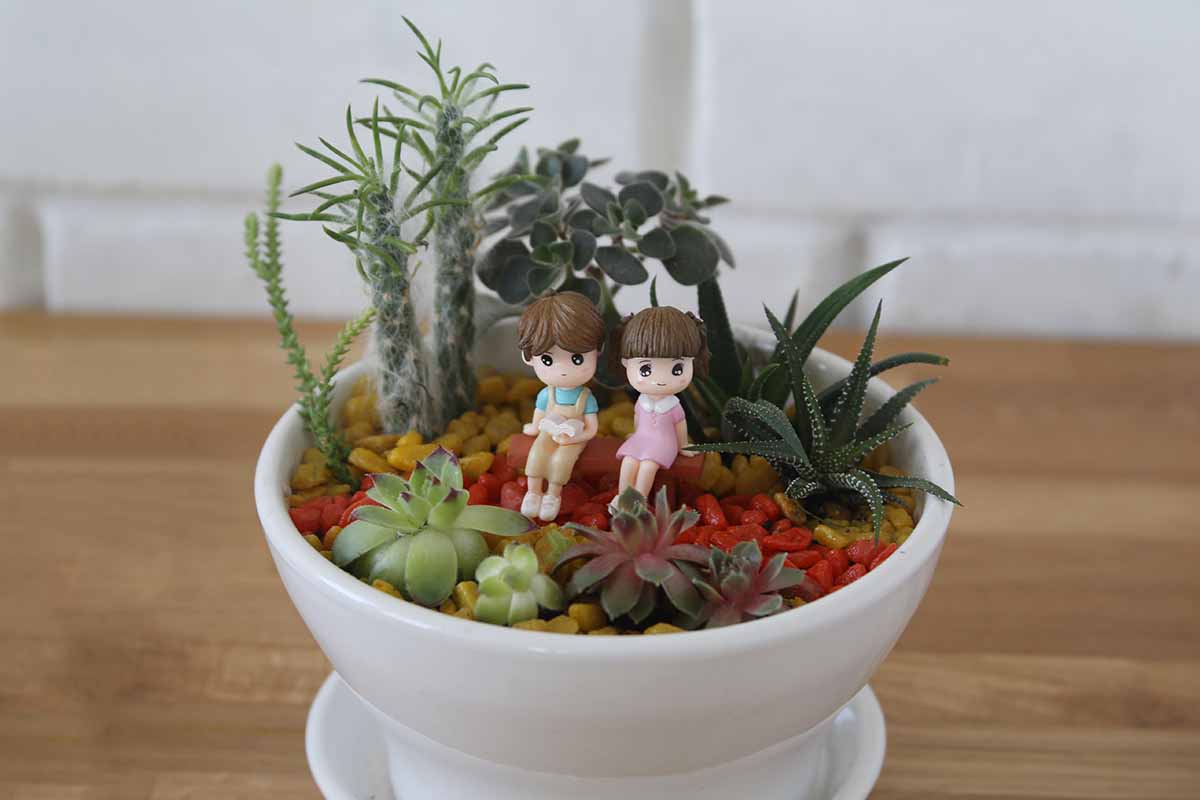
The scope of the project is whatever your heart desires. If you live in one of the warmest zones, you can work outdoors in the garden.
For those who don’t, myself included, we’ll create displays in containers that inspire us.
The Best Container
Select a well-draining container of any diameter you’d like to work with. Miniature succulents have shallow roots, so a depth of four inches is adequate.

If you are inclined to crafting, you can repurpose a vessel. Just be sure to drill at least one hole in the bottom for excess water to run out.
Whatever container you choose, place a drip pan or saucer beneath it.
Our article on succulent containers features exciting options from which to choose.
Once you have your vessel, wash it with a mild dish detergent and water and dry it.
Suitable Potting Soil
The best potting soil for our project is one formulated for cacti and succulents. Such products are loose, gritty, and well-draining while being moisture-retentive at the same time.
Our guide, How to Make Your Own Potting Soil for Succulents, has everything you need to know to mix a suitable potting soil.
Or, if you prefer, you can buy one.

Hoffman’s Cactus and Succulent Soil Mix
Hoffman’s Cactus and Succulent Soil Mix is available via Amazon.
When you plant in Hoffman’s mix, you ensure the roots are well aerated, the pH is appropriate, and the soil drains well.
Fill your container at least three-quarters full of potting soil. There should be no more than one inch of space between the soil’s surface and the container’s rim.
Assorted Supplies
Miniature tools are helpful when trying to manipulate small plants and figurines. You probably have most of what you’ll need around the house already.
You can use a clean artist’s paintbrush or cosmetic brush to dust off leaves and decorative items. The pointed end is also helpful for tracing lines in the potting soil to establish the location of paths and other design elements.
Dry measuring cups and spoons are convenient for scooping soil and accents like colorful gravel or sand.
Nail scissors make it easy to snip foliage as needed.
Gripping small items with tweezers makes them easy to place in a scene.
A shrimp or dessert fork makes a good rake for smoothing the soil. And an iced tea spoon with a long handle and narrow bowl may be just what you need to mound soil in a tight spot.
A squeeze squirt bottle lets you aim water at the soil level, avoiding wetting the leaves and dislodging figures.
Or, if you like, you can purchase a tool kit for tiny gardening.
In this comprehensive scaled-down kit, you’ll find rakes, scoops, shovels, snips, tweezers, watering equipment, and more.

Mini Garden Succulent Tools Set
One of my favorite pieces is the air dust blower for removing every speck of grit to keep plants and ornaments looking their best.
The Mini Garden Succulent Tools Set by SONGZIMING is available via Amazon.
And if you’re in the market for a new pair of gloves, see our review of the best gardening gloves.
Choosing a Theme
If you are a figurine collector, you can showcase them alongside your favorite succulent species.
Use a ratio of about two-thirds plants to one-third accessories so that the flora makes up the bulk of the display.
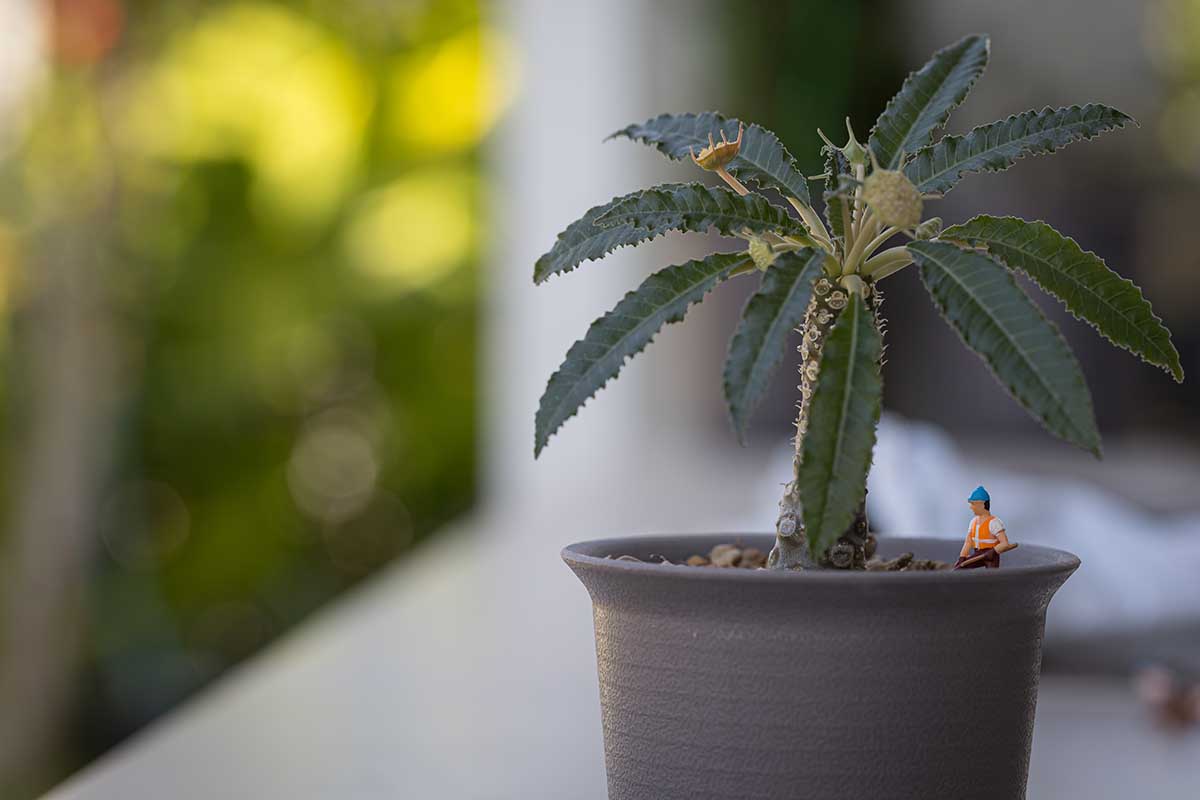
Consider perspective when designing. For example, an ambitious lumberjack may be much smaller than a tree.
Here are some theme ideas to inspire you:
- A Heavenly Oasis for Angels
- A Lumberjack’s Day in the Forest
- Dinosaurs on the Prowl
- Family Campout
- Jungle Safari
- Leprechauns on the Loose
- Superheroes to the Rescue
- Teddy Bear Tea Party
- Under the Sea
- Woodland Friends
Incorporate toys and miniature dollhouse furnishings, provided they can withstand the occasional accidental sprinkle with the watering can.
Character figures, chairs, dishes, and tables all have the potential to be focal points in your mini world.
Plants with a Purpose
When selecting flora species, consider what role they’ll play, as well as their size, shape, texture, and color.
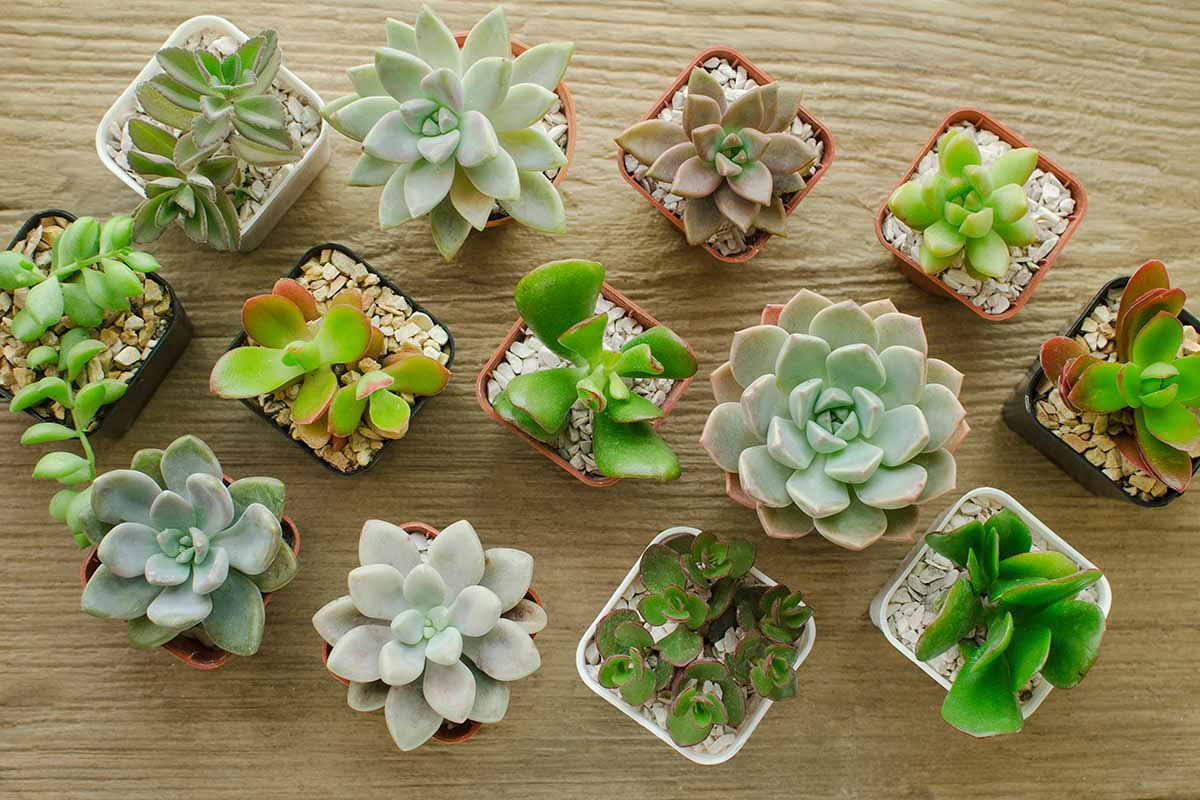
Do you imagine a world where your preschooler’s toy dinosaurs roam beneath tall trees?
Or perhaps a setting for your angel statues, among the flowers in a heavenly garden?

The arrangement with the angel in the photo is made in a multi-tiered pot designed for fairy gardens.
This two-tiered cut-away faux terra cotta container is made of resin and features a stairway connecting the upper and lower planting areas.

Mini Fairy Garden Succulent Planter Pot
Overall dimensions are small, at 6.5 inches wide, 1.5 inches tall, and 6.2 inches deep.
The Mini Fairy Garden Succulent Planter by Pacific Giftware is available from Amazon.
And here is a multi-tiered option:
This vessel is made of resin and features a crackled faux terra cotta finish and tiered sections.

Fairy Garden Pot with Sweet House
The planting sections are very small and hold tiny plants. Overall dimensions are a mere 6.89 inches tall, 6.69 inches wide, and 6.3 inches deep.
The Fairy Garden Pot with Sweet House by OUNONA is available via Amazon.
You can learn about different species in our article, 11 Best Easy-Care Succulents to Grow at Home.
Take note of mature dimensions as you plan your display, and select dwarf varieties of your favorites for your project.
If you can’t find a small version of a species you like, plan on pruning regularly to maintain the size you want.
Our articles on the art of bonsai may inspire you to approach your project from this creative direction.
Some of my favorite miniature species are:
- Crassula, such as jade plant, with a tree-like stem and leaves
- Echeveria, with its low-profile rosettes
- Gasteria, with its fan shape and tongue-like foliage
- Haworthia, spiky and speckled
- Lithops, multicolored living stones
- Sempervivum, a mother hen with her perky chicks
Here’s a source of quality plants for you to consider:
You’ll receive a beautiful array of miniature species in two-inch pots. Species vary according to availability.
Assorted Small Succulents are available from Succulent Gardens in packages of six, 10, or 64 plants.
And finally, consider incorporating air plants into your garden. They require no soil and can be removed for occasional misting and replaced afterward.
Accessorizing
The accessory items help to define the theme of your project. You’ll likely need a path for a walk in the woods, and a cottage may need a picket fence.
Collect natural items, like pebbles for paths and twigs for campfires. A pine cone makes an instant fir tree. A gleaming white clam shell, a sandy beach.
You can bring out your crafty side when setting your fanciful scene with repurposed materials, like bottle caps for stepping stones and popsicle stick “lumber” for building cabins and picnic tables.
In addition to figurines, found natural objects, and upcycled items, you can purchase decorative accessories. The possibilities are vast, friends!

Fairy Outdoor Garden Animals Figurines Hedgehogs and Mushrooms
If you’re after hedgehogs and toadstool fairy rings, Queekay offers packages of two brown resin hedgehogs measuring 1.6 inches long and 0.9 inches tall, and four red wooden mushrooms with white polka dots measuring an inch wide and 1.25 inches tall.
Fairy Outdoor Garden Animals Figurines Hedgehogs and Mushrooms by Queekay are available from Amazon.
And if you’re in the market for a faux water focal point, here’s a combination bridge and pond.
Cinda Stone Pond and Bridge Fairy Garden
This product is made of polyresin and looks like it’s been in place for many years.
Features include a weathered, stacked stone finish, wet-pond look, and swimming turtle. Measurements are 7 3/8 inches long, 7 3/4 inches wide, and 2 inches tall.
The August Grove® Cinda Stone Pond and Bridge Fairy Garden is available via Wayfair.
There are also complete accessory kits available with ready-made themes.
Here is one for those with a passion for gnomes.
You’ll stumble upon a gnome burrow with this brightly-colored resin set that includes a 15 1/2-inch faux log planting vessel, a squirrel-topped mushroom cottage, six stocking-capped gnomes, a tea table, wishing bridge, sprouting toadstools, and a resident frog.
Garden Gnomes Tiny Forest Friends Fairy Garden
In this type of display, the embellishments will dominate unless you use larger plants.
For example, if you wish to include a tall tree, a full-size jade plant may be a more logical choice than a dwarf species.
The Garden Gnomes Tiny Forest Friends Fairy Garden by Design Toscano is available via Wayfair.
Whatever your pleasure, choose accessories that support an overall theme for the best visual presentation.
Staging the Display
Use the back end of your artist’s brush, or a pencil, to “draw” paths and locations for flora and figures.
You can “erase” easily if you want to try various configurations by smoothing the indentations in the soil with your fork or rake.

Once you have your materials and a pretty good idea of where they will go, you can set each pot and accessory on top of the soil to see how it all lays out.
Begin with your largest thematic elements and plants first, and work the smaller ones in among them.
Leave at least one inch around each miniature plant to accommodate growth and promote airflow.
If you choose to incorporate larger flora into your design, take mature dimensions into account and space accordingly.
After seeing everything laid out, take a photo with your phone if you like, and lift everything off the soil for the next step.
Assembling the Contents
If you use large items, like the bridge and pond recommended above, settle them first, and then build your scene around them.

As mentioned, succulents have shallow roots. Carefully remove your chosen species from their starter pots. Loosen the soil and any visible roots.
Mound the soil a little and settle each plant into it so that the crown, where the foliage and roots meet, is even with the container’s rim. Add soil as needed. Avoid planting too deeply as it makes flora prone to rotting.
Add accessories as you go, remembering to leave at least an inch around plants for growing room. Should they grow larger than expected, you can prune them with your scissors as needed.
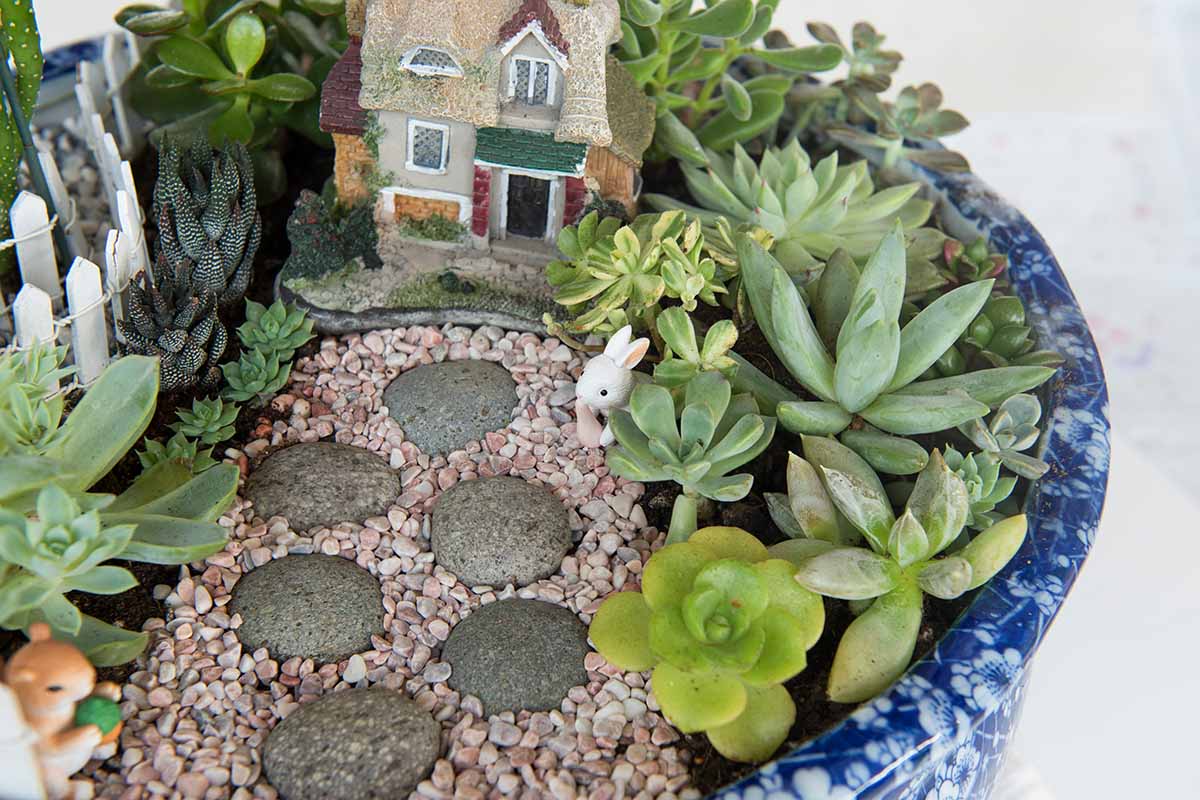
To create variations in elevation for your ornaments, slightly mound or scoop out the soil as needed.
When you’ve got everything where you want it, tamp the soil securely around the plants.
As a finishing touch, you may wish to purchase a small strand of battery-operated fairy lights to adorn your scene in the twilight hours.
Watering and Maintenance
Water at the soil level when your display is assembled – not over the leaves or decorations. Water until it runs from the drainage hole.
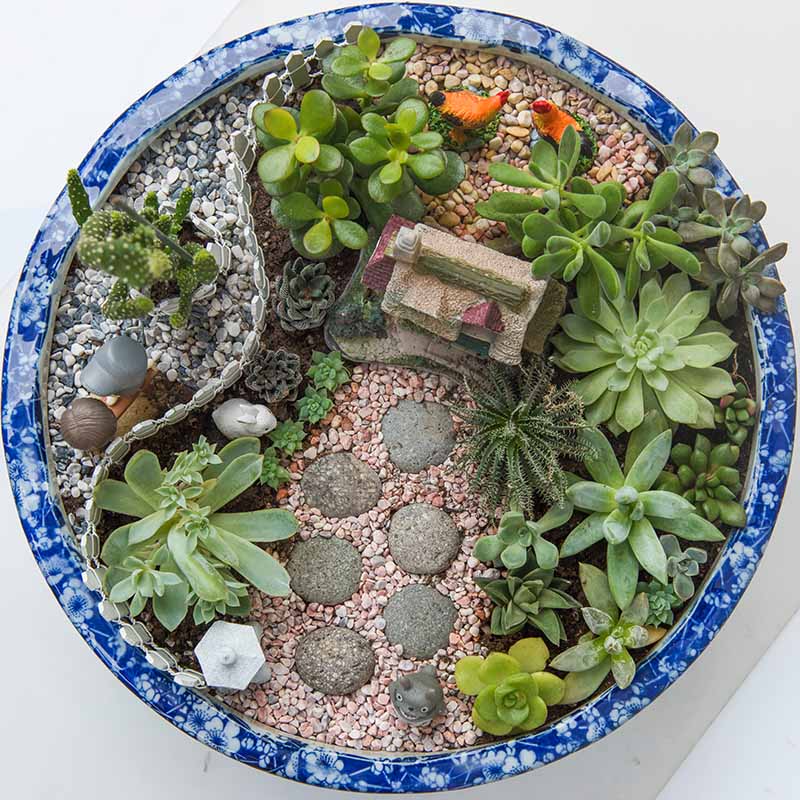
Tamp the soil around the plants and press the figurines gently to ensure they are firmly in place.
Place the container on a drip pan and put your finished project in a location with bright, indirect sunlight.
In the future, water only when the container completely dries out. You can use a moisture meter to guide you.
When growing succulents, tough love is essential. If you water them too soon, they are likely to rot.
However, with a well-draining container, loose and airy potting soil, and watering only when the soil dries out, you’re well on your way to success.
Learn more about water requirements for succulents here.
Fertilizer is not required. Prune as needed to maintain desired shapes or sizes, or to remove damaged or dead foliage.
Petite and Picturesque
Succulent fairy gardens are fun to keep or give as gifts. Put one on your desk and enjoy a mini escape with every glance.

Now that you’re ready to venture into miniatures, I recommend the book “Tiny Plants” by Leslie F. Halleck. In addition to succulents, you’ll find many other itty-bitty plants to love.
It’s time to choose your container and pick a theme for a petite and picturesque garden adventure!
Have you made a miniature succulent garden? Tell us about it in the comments section below, and please feel free to share your photos.
If you found this guide helpful and want to read more about succulents, we recommend the following:
